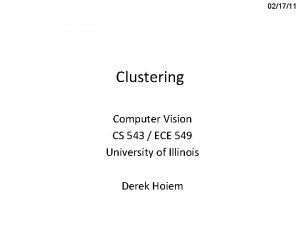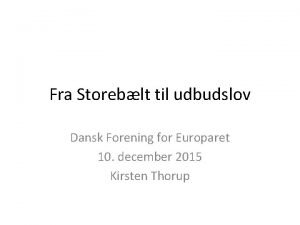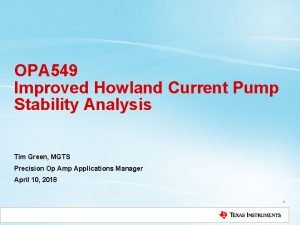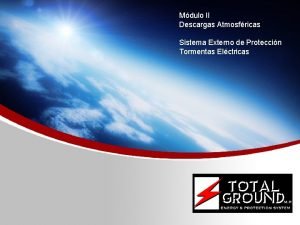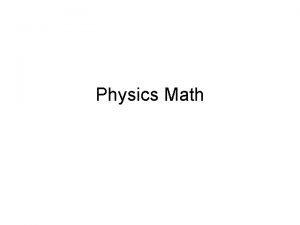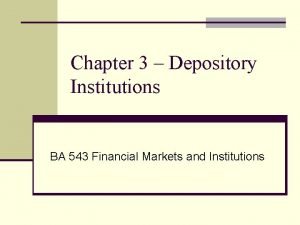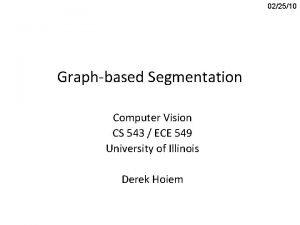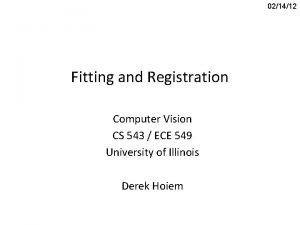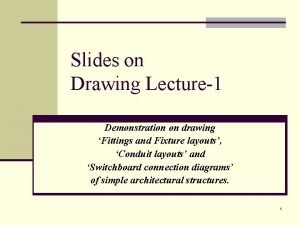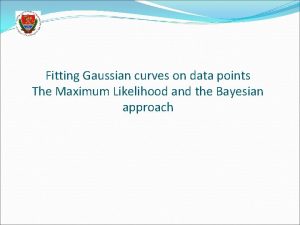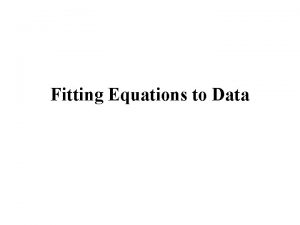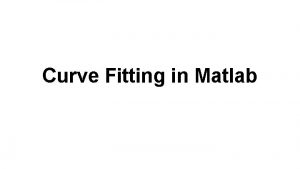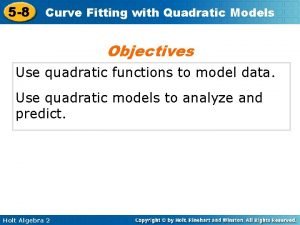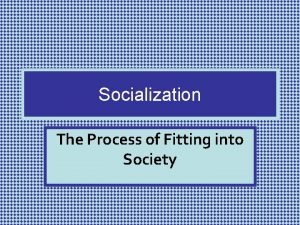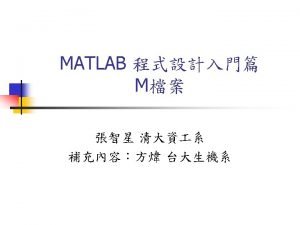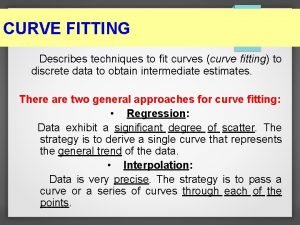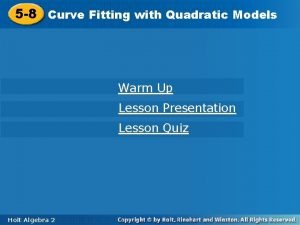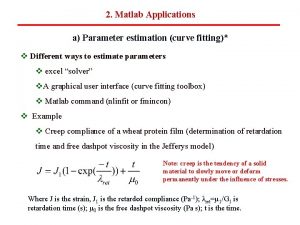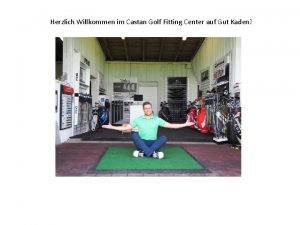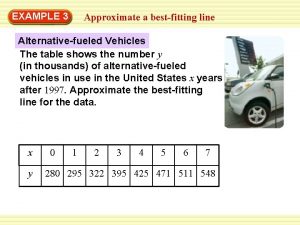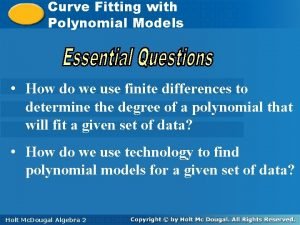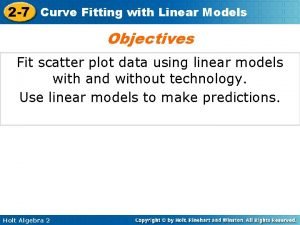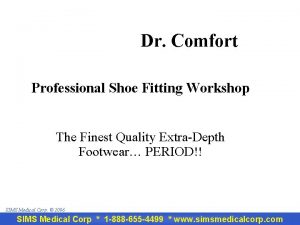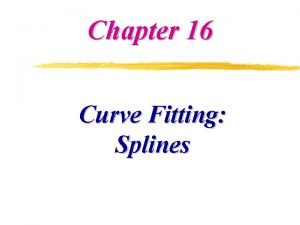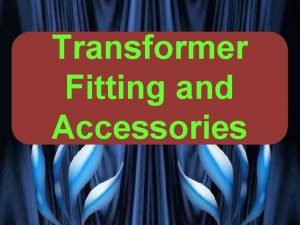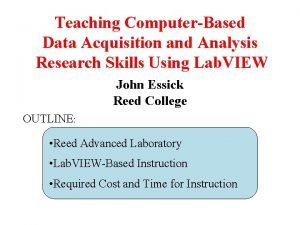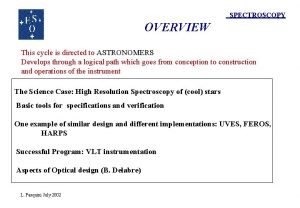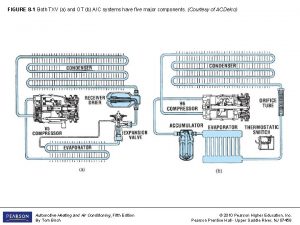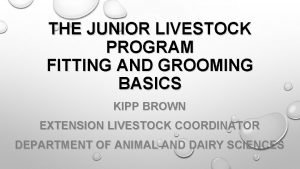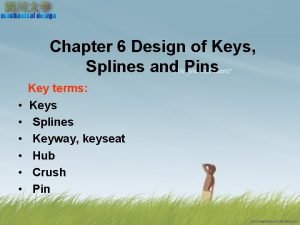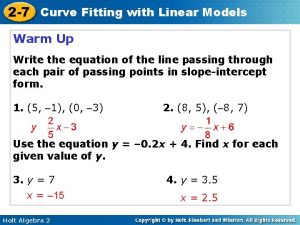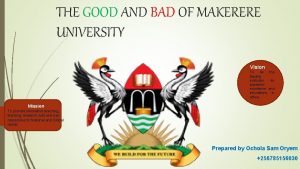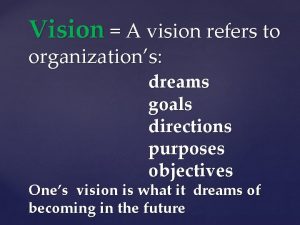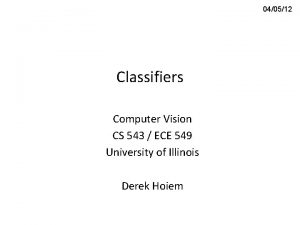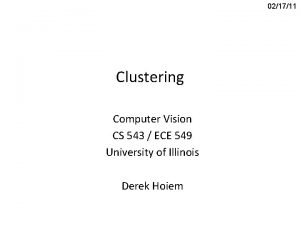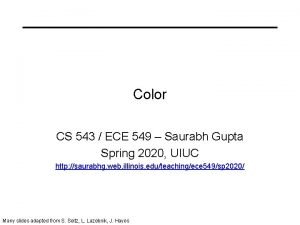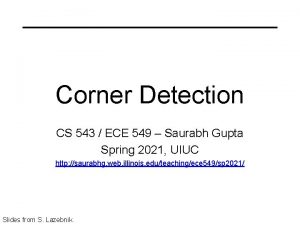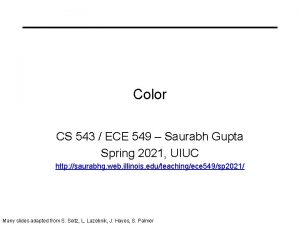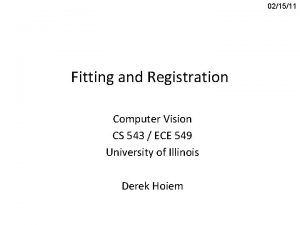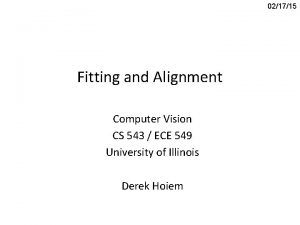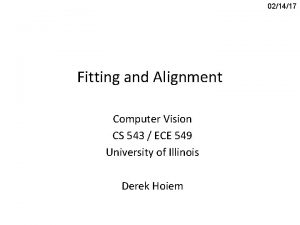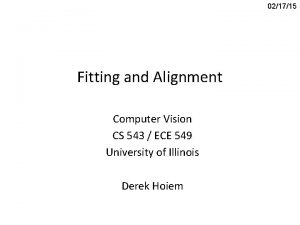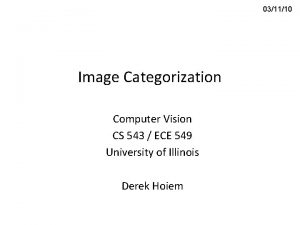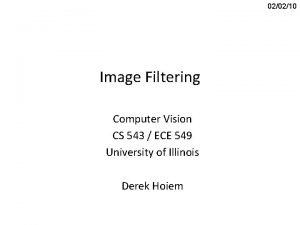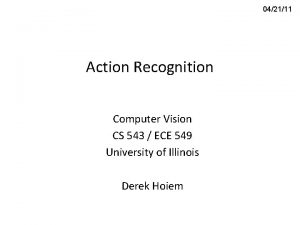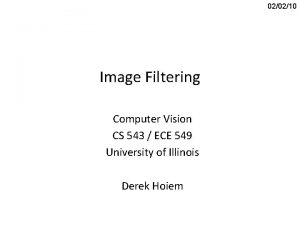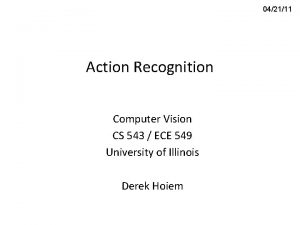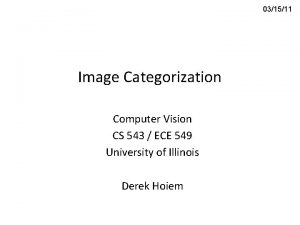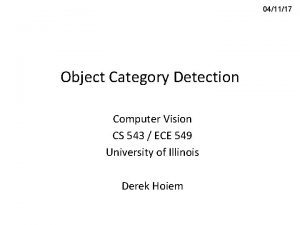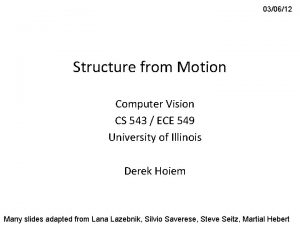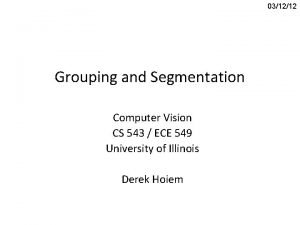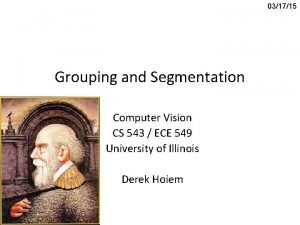Fitting Computer Vision CS 543 ECE 549 University












































- Slides: 44

Fitting Computer Vision CS 543 / ECE 549 University of Illinois Slides from Derek Hoiem, Svetlana Lazebnik

Fitting • We’ve learned how to detect edges, corners, blobs. Now what? • We would like to form a higher-level, more compact representation of the features in the image by grouping multiple features according to a simple model Slide from L. Lazebnik

Fitting • Choose a parametric model to represent a set of features simple model: lines simple model: circles complicated model: car Source: K. Grauman

Fitting Methods • Global optimization / Search for parameters – Least squares fit – Robust least squares • Hypothesize and test – Generalized Hough transform – RANSAC Slide from D. Hoiem

Simple example: Fitting a line Slide from D. Hoiem

Least squares line fitting • Data: (x 1, y 1), …, (xn, yn) • Line equation: yi = m xi + b • Find (m, b) to minimize y=mx+b (xi, yi) Matlab: p = A y; Modified from S. Lazebnik

Problem with “vertical” least squares • Not rotation-invariant • Fails completely for vertical lines Slide from S. Lazebnik

Total least squares If (a 2+b 2=1) then Distance between point (xi, yi) and line ax+by+c=0 is |axi + byi + c| proof: http: //mathworld. wolfram. com/Point. Line. Distance 2 -Dimensional. html Slide modified from S. Lazebnik ax+by+c=0 (xi, Unit normal: yi) N=(a, b)

Total least squares If (a 2+b 2=1) then Distance between point (xi, yi) and line ax+by+c=0 is |axi + byi + c| Find (a, b, c) to minimize the sum of squared perpendicular distances Slide modified from S. Lazebnik ax+by+c=0 (xi, Unit normal: yi) N=(a, b)

Total least squares Slide modified from S. Lazebnik Find (a, b, c) to minimize the sum of squared perpendicular distances ax+by+c=0 (xi, Unit normal: yi) N=(a, b) Solution is eigenvector corresponding to smallest eigenvalue of ATA See details on Raleigh Quotient: http: //en. wikipedia. org/wiki/Rayleigh_quotient

Recap: Two Common Optimization Problems Problem statement Solution (matlab) Problem statement Slide from D. Hoiem Solution

Least squares (global) optimization Good • Clearly specified objective • Optimization is easy Bad • May not be what you want to optimize • Sensitive to outliers – Bad matches, extra points • Doesn’t allow you to get multiple good fits – Detecting multiple objects, lines, etc. Slide from D. Hoiem

Least squares: Robustness to noise • Least squares fit to the red points: Slide from L. Lazebnik

Least squares: Robustness to noise • Least squares fit with an outlier: Problem: squared error heavily penalizes outliers Slide from L. Lazebnik

Robust least squares (to deal with outliers) General approach: minimize ui (xi, θ) – residual of ith point w. r. t. model parameters θ ρ – robust function with scale parameter σ The robust function ρ • Favors a configuration with small residuals • Constant penalty for large residuals Slide from S. Savarese

Robust Estimator • Slide from D. Hoiem

Choosing the scale: Just right The effect of the outlier is minimized Slide from L. Lazebnik

Choosing the scale: Too small The error value is almost the same for every point and the fit is very poor Slide from L. Lazebnik

Choosing the scale: Too large Behaves much the same as least squares Slide from L. Lazebnik

Other ways to search for parameters (for when no closed form solution exists) • Line search 1. 2. • Grid search 1. 2. • For each parameter, step through values and choose value that gives best fit Repeat (1) until no parameter changes Propose several sets of parameters, evenly sampled in the joint set Choose best (or top few) and sample joint parameters around the current best; repeat Gradient descent 1. 2. Slide from D. Hoiem Provide initial position (e. g. , random) Locally search for better parameters by following gradient

Hypothesize and test 1. Propose parameters – – – Try all possible Each point votes for all consistent parameters Repeatedly sample enough points to solve for parameters 2. Score the given parameters – Number of consistent points, possibly weighted by distance 3. Choose from among the set of parameters – Global or local maximum of scores 4. Possibly refine parameters using inliers Slide from D. Hoiem

Hough Transform: Outline 1. Create a grid of parameter values 2. Each point votes for a set of parameters, incrementing those values in grid 3. Find maximum or local maxima in grid Slide from D. Hoiem

Hough transform P. V. C. Hough, Machine Analysis of Bubble Chamber Pictures, Proc. Int. Conf. High Energy Accelerators and Instrumentation, 1959 Given a set of points, find the curve or line that explains the data points best y m x y=mx+b Hough space b Slide from S. Savarese

Hough transform y m b x y m 3 x Slide from S. Savarese 5 3 3 2 2 3 7 11 10 4 3 2 1 1 0 5 3 2 3 4 1 b

Hough transform P. V. C. Hough, Machine Analysis of Bubble Chamber Pictures, Proc. Int. Conf. High Energy Accelerators and Instrumentation, 1959 Issue : parameter space [m, b] is unbounded… Use a polar representation for the parameter space y x Hough space Slide from S. Savarese

Hough transform - experiments features votes Slide from S. Savarese

Hough transform - experiments Noisy data features votes Need to adjust grid size or smooth Slide from S. Savarese

Hough transform - experiments features votes Issue: spurious peaks due to uniform noise Slide from S. Savarese

1. Image Canny Slide from D. Hoiem

2. Canny Hough votes Slide from D. Hoiem

3. Hough votes Edges Find peaks and post-process Slide from D. Hoiem

Hough transform example Slide from D. Hoiem http: //ostatic. com/files/images/ss_hough. jpg

Finding circles (x 0, y 0, r) using Hough transform • Fixed r • Variable r Slide from D. Hoiem

Hough transform for circles image space Hough parameter space r y (x, y) x x y Slide from L. Lazebnik

Incorporating image gradients • When we detect an edge point, we also know its gradient orientation • How does this constrain possible lines passing through the point? • Modified Hough transform: • For each edge point (x, y) θ = gradient orientation at (x, y) ρ = x cos θ + y sin θ H(θ, ρ) = H(θ, ρ) + 1 end Slide from L. Lazebnik

Hough transform conclusions Good • Robust to outliers: each point votes separately • Fairly efficient (much faster than trying all sets of parameters) • Provides multiple good fits Bad • Some sensitivity to noise • Bin size trades off between noise tolerance, precision, and speed/memory – Can be hard to find sweet spot • Not suitable for more than a few parameters – grid size grows exponentially Common applications • Line fitting (also circles, ellipses, etc. ) • Object instance recognition (parameters are position/scale/orientation) • Object category recognition (parameters are position/scale) Slide from D. Hoiem

RANSAC (RANdom SAmple Consensus) : Fischler & Bolles in ‘ 81. Algorithm: 1. Sample (randomly) the number of points required to fit the model 2. Solve for model parameters using samples 3. Score by the fraction of inliers within a preset threshold of the model Repeat 1 -3 until the best model is found with high confidence Slide from D. Hoiem

RANSAC Line fitting example Algorithm: 1. Sample (randomly) the number of points required to fit the model (#=2) 2. Solve for model parameters using samples 3. Score by the fraction of inliers within a preset threshold of the model Repeat 1 -3 until the best model is found with high confidence Slide from D. Hoiem Illustration by Savarese

RANSAC Line fitting example Algorithm: 1. Sample (randomly) the number of points required to fit the model (#=2) 2. Solve for model parameters using samples 3. Score by the fraction of inliers within a preset threshold of the model Repeat 1 -3 until the best model is found with high confidence Slide from D. Hoiem

RANSAC Line fitting example Algorithm: 1. Sample (randomly) the number of points required to fit the model (#=2) 2. Solve for model parameters using samples 3. Score by the fraction of inliers within a preset threshold of the model Repeat 1 -3 until the best model is found with high confidence Slide from D. Hoiem

RANSAC Algorithm: 1. Sample (randomly) the number of points required to fit the model (#=2) 2. Solve for model parameters using samples 3. Score by the fraction of inliers within a preset threshold of the model Repeat 1 -3 until the best model is found with high confidence Slide from D. Hoiem

How to choose parameters? • Number of samples N – Choose N so that, with probability p, at least one random sample is free from outliers (e. g. p=0. 99) (outlier ratio: e ) • Number of sampled points s – Minimum number needed to fit the model • Distance threshold – Choose so that a good point with noise is likely (e. g. , prob=0. 95) within threshold – Zero-mean Gaussian noise with std. dev. σ: t 2=3. 84σ2 proportion of outliers e s 2 3 4 5 6 7 8 Slide from D. Hoiem 5% 2 3 3 4 4 4 5 10% 3 4 5 6 7 8 9 20% 25% 30% 40% 5 6 7 11 17 7 9 11 19 35 9 13 17 34 72 12 17 26 57 146 16 24 37 97 293 20 33 54 163 588 26 44 78 272 1177 modified from M. Pollefeys

RANSAC conclusions Good • Robust to outliers • Applicable for larger number of objective function parameters than Hough transform • Optimization parameters are easier to choose than Hough transform Bad • Computational time grows quickly with fraction of outliers and number of parameters • Not as good for getting multiple fits (though one solution is to remove inliers after each fit and repeat) Common applications • Computing a homography (e. g. , image stitching) • Estimating fundamental matrix (relating two views) Slide from D. Hoiem

Fitting Summary • Least Squares Fit – closed form solution – robust to noise – not robust to outliers • Robust Least Squares – improves robustness to noise – requires iterative optimization • Hough transform – robust to noise and outliers – can fit multiple models – only works for a few parameters (1 -4 typically) • RANSAC – robust to noise and outliers – works with a moderate number of parameters (e. g, 1 -8) Slide from D. Hoiem
 Ece 543
Ece 543 Ece 549 uiuc
Ece 549 uiuc Ece549
Ece549 Structured light
Structured light Unit 543 research project examples
Unit 543 research project examples C-549/14
C-549/14 Opa 549
Opa 549 Nmx-j-549-ance-2005
Nmx-j-549-ance-2005 Express 549,000 in scientific notation.
Express 549,000 in scientific notation. 543 machine
543 machine Ba 543
Ba 543 Ba 543
Ba 543 Ba 543
Ba 543 Cs 543
Cs 543 Cs 543
Cs 543 Conduit layout drawing
Conduit layout drawing Pilkington spider fitting
Pilkington spider fitting Gaussian curve fitting
Gaussian curve fitting Fitting equations to data
Fitting equations to data Curve fitting matlab
Curve fitting matlab Curve fitting with quadratic models
Curve fitting with quadratic models Fitting into society
Fitting into society Matlab sine fitting
Matlab sine fitting Curve fitting with exponential and logarithmic models
Curve fitting with exponential and logarithmic models Curve fitting techniques
Curve fitting techniques Curve fitting with quadratic models
Curve fitting with quadratic models Parameter estimation in matlab
Parameter estimation in matlab Castan golf fitting
Castan golf fitting Approximate the best fitting line for the data
Approximate the best fitting line for the data Curve fitting with polynomial models
Curve fitting with polynomial models Curve fitting with linear models
Curve fitting with linear models Dr comfort return form
Dr comfort return form Butler system heat exchanger
Butler system heat exchanger Quadratic spline interpolation matlab
Quadratic spline interpolation matlab Transformer fitting
Transformer fitting Labview curve fitting
Labview curve fitting Main sequence fitting
Main sequence fitting A/c fitting size chart
A/c fitting size chart Steer clipping and fitting techniques
Steer clipping and fitting techniques Spline key diagram
Spline key diagram Curve fitting with linear models
Curve fitting with linear models Boston university ece
Boston university ece Makerere university vision
Makerere university vision Core values of slu
Core values of slu 16-385 cmu
16-385 cmu


